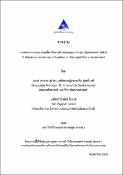บทคัดย่อ
เมื่อยาที่มีราคาแพงหรือยาใหม่ที่มีข้อมูลเกี่ยวกับประสิทธิภาพของยาที่ยังไม่สมบูรณ์ออกสู่ตลาด จะมีผลกระทบต่อผู้ซื้อบริการสุขภาพในฐานะที่เป็นผู้จ่ายเงินในระบบสุขภาพ การทำข้อตกลงในรูปแบบ managed entry agreement หรือ MEA เป็นวิธีการหนึ่งที่มีการใช้อย่างแพร่หลายในหลายประเทศ อาทิ สหราชอาณาจักร สองในสามของประเทศสมาชิกองค์การเพื่อความร่วมมือทางเศรษฐกิจและการพัฒนา (Organization for Economic Co-operation and Development หรือ OECD) ซึ่งประเทศสมาชิกสหภาพยุโรปมีการทำข้อตกลงในรูปแบบ MEA แบ่งได้เป็น 2 ประเภท ได้แก่ ข้อตกลงทางการเงินที่เรียกว่า financial–based agreement และข้อตกลงตามประสิทธิภาพที่เรียกว่า performance–based agreement สำหรับข้อตกลงประเภท financial–based agreement มีความมุ่งหมายที่จะจำกัดผลกระทบต่องบประมาณผ่านวิธีการควบคุมต้นทุนของยา แต่รายละเอียดที่อยู่ในข้อตกลงเป็นความลับทำให้ขาดความโปร่งใส อาจทำให้ผู้จ่ายเงินบางรายได้รับประโยชน์จากรายละเอียดดังกล่าว สามารถทำได้ใน 2 ระดับ ได้แก่ ระดับประชากรและระดับผู้ป่วย ในระดับประชากรประกอบด้วยข้อตกลง MEA ในรูปแบบ discount / rebate, price–volume agreement และ expenditure cap และในระดับผู้ป่วย ประกอบด้วยข้อตกลง MEA ในรูปแบบ free initiation treatment, utilization cap ที่ให้ความคุ้มครองการรักษากับผู้ป่วยในแต่ละราย ส่วนข้อตกลงประเภท performance–based agreement เป็นข้อตกลงตามประสิทธิภาพการรักษาที่เกิดขึ้นจริง บางครั้งเรียกว่า health outcome based agreement แบ่งได้เป็น 2 กลุ่ม กลุ่มแรก มีความมุ่งหมายที่จะจัดการกับการนำยามาใช้ให้เกิดประโยชน์สูงสุด เรียกว่า performance linked reimbursement ประกอบด้วยข้อตกลง MEA ในรูปแบบ conditional treatment continuation และ pay by result กลุ่มที่สอง มีความมุ่งหมายที่จะจัดการกับความไม่แน่นอนเกี่ยวกับประสิทธิภาพของยา ด้วยการศึกษาวิจัยเพื่อหาข้อมูลยาเพิ่มเติม ข้อตกลง MEA ในรูปแบบนี้เรียกว่า coverage with evidence development หรือ CED ซึ่งเป็นวิธีการแก้ไขปัญหาที่ดี แต่มีความซับซ้อนในการดำเนินการ ส่งผลกระทบต่อผู้มีส่วนได้เสียในระบบสุขภาพอย่างกว้างขวางและมีค่าใช้จ่ายในการดำเนินการสูง อย่างไรก็ตาม ผู้ที่มีอำนาจในการตัดสินใจในระบบสุขภาพจะต้องพิจารณาเลือกใช้และทำข้อตกลง MEA อย่างรอบคอบ เนื่องจากข้อตกลง MEA ในแต่ละรูปแบบมีจุดเด่น ข้อจำกัด ที่แตกต่างกัน เพื่อให้การใช้งบประมาณเป็นไปอย่างมีประสิทธิภาพและผู้ป่วยเข้าถึงยาได้อย่างเท่าเทียม
บทคัดย่อ
When high–price drugs or new drugs with immature information about their efficacy come to market, will cause uncertainty in the health systems, especially for health–service buyers as the payers in the health systems. Managed Entry Agreement (MEA) is the tools for manage uncertainty that are widely used in many countries such as United Kingdom, two third of OECD member countries, European Union countries. MEA can be divided into two types: financial–based agreement and performance–based agreement. The financial–based agreement aims to limit budget impact through controlling drug costs. It is a simple method, effective in reduce drug prices and limit budget impact, but the details contained in the agreement are confidential, resulting in a lack of transparency. It may give some payers the benefit of such details. It can be implemented at 2 levels: population level and patient level. At the population level, consists of MEA in the model of discount / rebate, price–volume agreement, and expenditure cap. At the patient level, consists of MEA in the model of free initiation treatment and utilization cap that provides individual patient coverage. The performance–based agreement is an agreement based on the actual treatment efficacy. Sometimes referred to as health outcome–based agreement. This agreement is divided in two groups. The first group aims to optimize drug use, known as performance linked reimbursement, which consists of MEA in the model of conditional treatment continuation and pay by result. The second group aims to address uncertainty about drug efficacy with more research studies. This model of MEA is known as coverage with evidence development, or CED. It is a good solution to the problems, but it is complicated to operate, and affect stakeholders in the health systems widely, and high cost in operation. However, the decision–makers in the health system should carefully consider in the selection and implementation of MEA, as each model of MEA has different strengths and limitations, for efficient budgeting and equal access to medicines.


